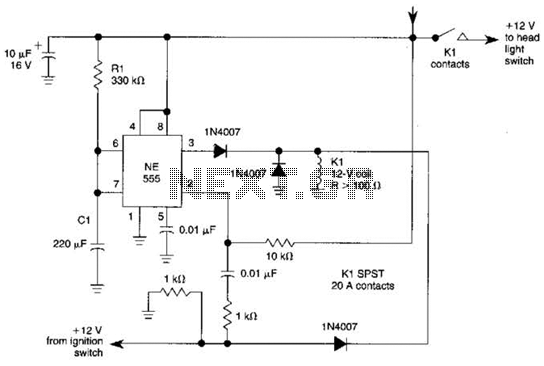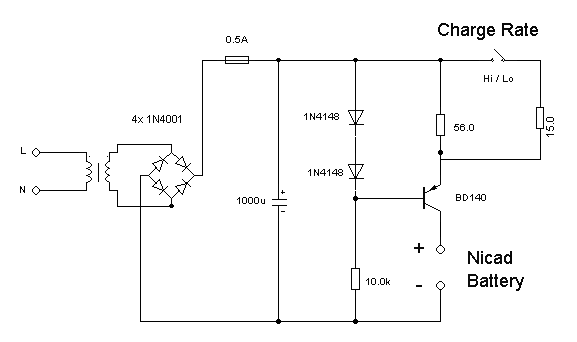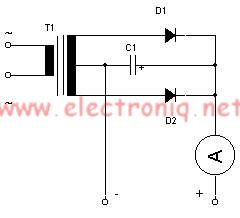
automatic battery charger

This automatic battery charger circuit is ideal for charging batteries used in alarm systems that require battery buffering. Caution must be exercised when connecting the battery to ensure correct AC polarity. It is essential to meticulously follow the schematic during the assembly of components. A power supply providing an input of 14-15V with a maximum current of 3A is required.
This automatic battery charger circuit is designed to efficiently charge batteries utilized in alarm systems, ensuring they remain operational during power outages. The circuit typically includes a transformer, rectifier, voltage regulator, and various passive components that work in unison to provide a stable charging voltage and current.
The transformer steps down the AC mains voltage to a lower AC voltage, typically in the range of 14-15V, which is suitable for charging lead-acid batteries. The rectifier converts the AC voltage to DC, allowing the battery to be charged. A bridge rectifier configuration is commonly used to ensure full-wave rectification, enhancing charging efficiency.
Following the rectification stage, a voltage regulator is employed to maintain a consistent output voltage, preventing overcharging of the battery. This is critical for prolonging the life of the battery and ensuring safe operation. The regulator may incorporate feedback mechanisms to adjust the output based on the battery's state of charge.
Additional components such as capacitors are included to filter any ripple voltage resulting from the rectification process, providing a smoother DC output. Diodes may also be used for protection against reverse polarity connections, safeguarding the circuit against potential damage.
When assembling the circuit, it is crucial to adhere strictly to the schematic, ensuring that all components are placed correctly and securely. This includes verifying the orientation of polarized components, such as electrolytic capacitors and diodes, to prevent circuit failure.
In summary, this automatic battery charger circuit is tailored for alarm systems requiring reliable battery charging. Proper attention to detail during assembly and connection is paramount for ensuring safe and effective operation.The use of this automatic battery charger circuit is perfect for charging batteries for alarm systems with battery buffering. During the insertion, so be careful with the connection to the battery with the AC polarity. For mounting components, you must carefully follow the completion of the schematic. Put 14-15V input with 3A max current power supply. 🔗 External reference
This automatic battery charger circuit is designed to efficiently charge batteries utilized in alarm systems, ensuring they remain operational during power outages. The circuit typically includes a transformer, rectifier, voltage regulator, and various passive components that work in unison to provide a stable charging voltage and current.
The transformer steps down the AC mains voltage to a lower AC voltage, typically in the range of 14-15V, which is suitable for charging lead-acid batteries. The rectifier converts the AC voltage to DC, allowing the battery to be charged. A bridge rectifier configuration is commonly used to ensure full-wave rectification, enhancing charging efficiency.
Following the rectification stage, a voltage regulator is employed to maintain a consistent output voltage, preventing overcharging of the battery. This is critical for prolonging the life of the battery and ensuring safe operation. The regulator may incorporate feedback mechanisms to adjust the output based on the battery's state of charge.
Additional components such as capacitors are included to filter any ripple voltage resulting from the rectification process, providing a smoother DC output. Diodes may also be used for protection against reverse polarity connections, safeguarding the circuit against potential damage.
When assembling the circuit, it is crucial to adhere strictly to the schematic, ensuring that all components are placed correctly and securely. This includes verifying the orientation of polarized components, such as electrolytic capacitors and diodes, to prevent circuit failure.
In summary, this automatic battery charger circuit is tailored for alarm systems requiring reliable battery charging. Proper attention to detail during assembly and connection is paramount for ensuring safe and effective operation.The use of this automatic battery charger circuit is perfect for charging batteries for alarm systems with battery buffering. During the insertion, so be careful with the connection to the battery with the AC polarity. For mounting components, you must carefully follow the completion of the schematic. Put 14-15V input with 3A max current power supply. 🔗 External reference





